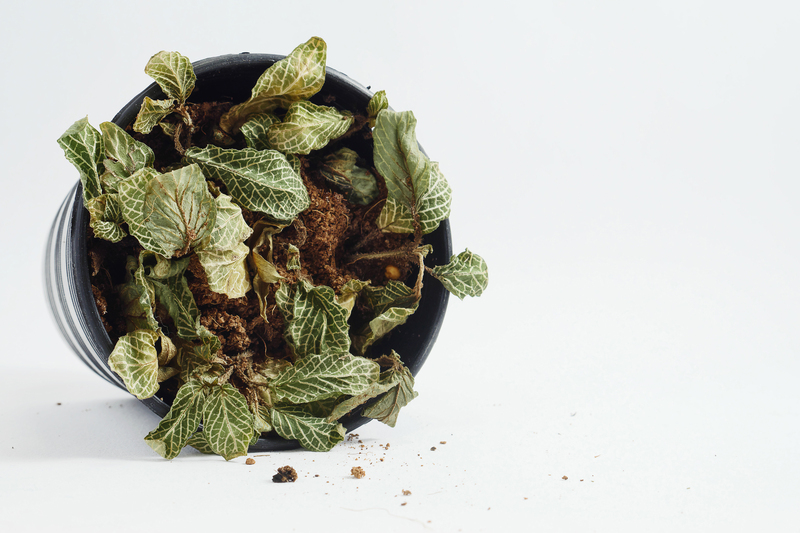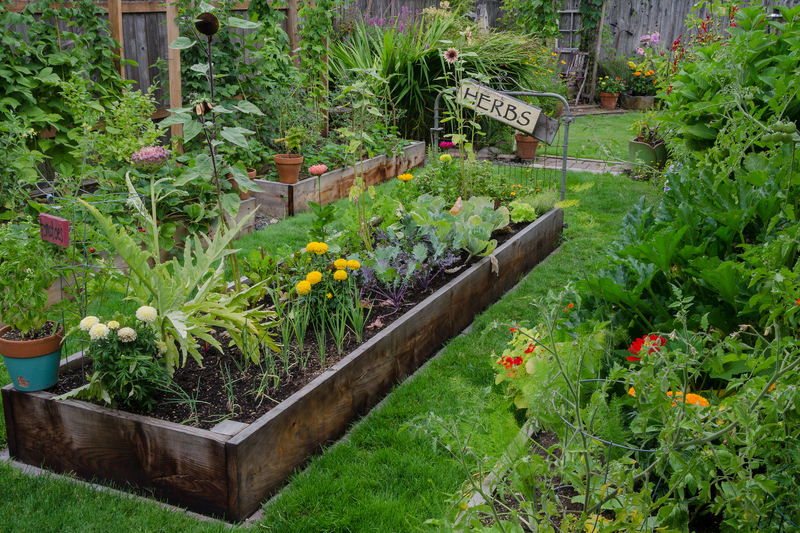Why Container Gardening is Perfect for Small Spaces
Posted on 22/08/2025
Why Container Gardening is Perfect for Small Spaces
Container gardening is an increasingly popular solution for city dwellers and those with limited outdoor space. Unlike traditional gardening, which requires ample ground, container gardens thrive in balconies, patios, windowsills, and even indoors. Whether you're an apartment resident, a beginner gardener, or simply battling for space, the benefits of growing plants in containers are numerous--and transformative.
Understanding Container Gardening: An Urban Revolution
Container gardening is the practice of growing plants exclusively in containers instead of planting them in the ground. Thanks to its flexibility and adaptability, this technique has become the go-to gardening method for people worldwide who are striving to bring a bit of green into compact living spaces.
- Adaptable: Containers can be placed anywhere--window ledges, rooftops, inside apartments, and even along sunny staircases.
- Efficient: They maximize whatever little area you have, making it easy to indulge in gardening without a traditional yard.
- Versatile: Suitable for growing everything from lush flowers to hearty vegetables and fragrant herbs.

Key Benefits of Container Gardening in Small Spaces
1. Space Optimization
Maximizing limited space is the hallmark of container gardening. Small balconies, little patios, tiny terraces, and windowsills can become green oases by smartly placing pots, planters, and hanging baskets. This makes container gardening ideal for apartments and urban homes, turning even the smallest area into a productive green retreat.
2. Portability and Flexibility
One of the biggest advantages of container gardening is the ability to move your plants around. Not happy with your garden's layout? Simply rearrange your pots. Need to protect delicate plants from bad weather? Move them indoors or to a sheltered spot. This mobility also allows for creative design, letting you easily switch up the look of your space.
- Seasonal changes: Shift containers to maximize sunlight exposure during winter and create shady corners in the heat of summer.
- Protect plants: Move tender or young plants indoors during cold snaps or storms.
- Instant refresh: Change the arrangement of your containers to freshen the look of your space anytime.
3. Improved Control Over Growing Conditions
Container gardening allows precise control over soil quality, moisture levels, and sunlight exposure, which can be difficult in a traditional plot. If your yard has poor soil, or no soil at all, containers are the perfect solution for creating the ideal environment for your chosen plants.
- Choose the right soil: Mix potting soil, compost, and fertilizers to meet specific plant needs.
- Drainage control: Containers typically have drainage holes, reducing the risk of root rot and overwatering.
- Microclimates: Place heat-loving plants in sunny spots, or move shade-lovers to cool, protected areas.
4. Low Maintenance Commitment
Gardening in containers is easier on your back and schedule. Smaller growing areas mean less weeding, reduced exposure to garden pests, and fewer hours spent on maintenance. This makes container gardening an attractive option for busy individuals or those with limited physical capabilities.
- Less weeding: Controlled soil means fewer pests and weeds.
- Reduced tasks: Watering, fertilizing, and pruning can be quick and convenient.
- Accessibility: Place containers at a comfortable height for easy care.
5. Versatility in Plant Choices
You might think that having limited space would restrict your plant options, but container gardening opens up a surprising range of possibilities. Almost anything you can grow in a garden, you can grow in a pot--if you choose the right container size.
- Herbs and vegetables: Basil, mint, parsley, tomatoes, peppers, and lettuce all thrive in containers.
- Ornamental plants: Choose flowers, small shrubs, or decorative grasses to bring color and life to your small space.
- Edible and decorative: Strawberries, blueberries, and edible flowers are both attractive and delicious.
Best Containers for Small-Space Gardens
Selecting the right containers is crucial. Before you start your compact garden journey, consider the following options:
- Terracotta pots: Classic, porous, and attractive, but may dry out quickly in hot climates.
- Plastic containers: Lightweight and retain moisture well, perfect for balconies or ledges.
- Ceramic planters: Offer beauty and durability but can be heavy and expensive.
- Wooden boxes: Rustic look and insulation for plant roots, though they may degrade over time if not treated.
- Recycled items: Old buckets, crates, and even teacups can serve as unique, eco-friendly containers.
- Hanging baskets and vertical planters: Excellent for maximizing vertical space, ideal for trailing plants and herbs.
Choosing the Right Plants for Your Small-Space Container Garden
Plant selection is vital. Small but productive plants are best when garden space is at a premium. Here are some excellent candidates for small-space container gardening:
Best Edible Plants
- Leafy greens: Lettuce, spinach, kale, and Swiss chard grow quickly and can be harvested frequently.
- Herbs: Basil, mint, thyme, rosemary, and cilantro are compact, fragrant, and perfect for culinary use.
- Cherry tomatoes: Dwarf varieties thrive in pots and are prolific fruiters.
- Peppers: Hot and sweet peppers are compact and add vibrant color.
- Strawberries: Ideal for hanging baskets and small containers.
Best Ornamental Plants
- Petunias and pansies: Provide vivid color throughout the season.
- Succulents: Require little maintenance and are highly decorative.
- Miniature roses: Bring romance and fragrance to balconies and windowsills.
- Begonias and fuchsias: Thrive in shadier spots, adding lushness and charm.
How to Start Your Container Garden in a Small Space
Ready to take the plunge into small-space container gardening? Here's a step-by-step guide to help you hit the ground running:
Step 1: Evaluate Your Space
Assess the sunlight, wind exposure, and overall size of your potential gardening area. Determine whether you'll be gardening indoors on a windowsill, on a small patio, or a balcony. Sunlight is crucial for most plants, so pick a space that gets at least six hours of sun a day.
Step 2: Select Appropriately Sized Containers
Choose pots and planters based on the plants you aim to grow. Larger containers retain moisture better, while smaller ones are perfect for herbs and compact flowers. Ensure all containers have adequate drainage holes to prevent waterlogging.
Step 3: Prepare Quality Soil
Invest in a high-quality commercial potting mix or make your own blend using peat moss, compost, and perlite. Good potting soil supports healthy root growth and adequate drainage--keys to a successful container garden.
Step 4: Plant and Arrange Creatively
Space your plants according to their growing requirements and the size of the container. Combine plants with similar water, sunlight, and soil needs. Experiment with color contrasts, heights, and textures for maximum visual impact.
Step 5: Maintain and Enjoy
Water your containers regularly--daily in hot weather. Fertilize as needed, prune dead leaves, and look out for pests. Most importantly, enjoy the process and beauty of nurturing life in your limited space!
Creative Ideas to Maximize Container Gardening in Tiny Spaces
Vertical Gardening
Harness the power of vertical space with wall-mounted planters, trellises, and stackable pots. This approach not only optimizes area but also creates living art installations that can transform bland walls or fences into lush green tapestries.
Hanging Gardens
Utilize ceiling hooks, railing brackets, and even window frames for hanging planters. Trailing vines, flowers, and edible crops like strawberries do particularly well in suspended containers.
Tiered Plant Stands and Shelves
Tiered plant stands or recycled shelves let you display multiple containers at once, making efficient use of floor space and creating attractive layers of greenery.
Window Boxes and Rail Planters
Don't overlook your windowsills and balcony rails! Compact window boxes are ideal for herbs, leafy greens, and flowers, creating color and texture where you least expect it.

Common Challenges and Solutions in Small-Space Container Gardening
Challenge: Overcrowding
It's tempting to pack many plants into a single pot, but overcrowding leads to competition for water and nutrients. Solution: Stick to recommended spacing and select compact plant varieties for a healthier garden.
Challenge: Water Management
Containers can dry out quickly or become waterlogged. Solution: Use moisture-retaining potting mixes, mulch the soil surface, and ensure containers have sufficient drainage holes.
Challenge: Limited Sunlight
Not all spaces get ample sunlight. Solution: Choose shade-tolerant plants or supplement with grow lights where needed. Reflective surfaces can also redirect sunlight to dim corners.
Conclusion: Bring Greenery to Every Nook and Cranny
Container gardening is perfect for small spaces because it's simple, customizable, and nurturing for both plants and gardeners. By making the most of every square inch--whether through creative vertical systems, thoughtful plant choices, or portable pots--everyone can enjoy the rewards of urban gardening, however limited their available space.
In summary, container gardens offer flexibility, productivity, and beauty all in one. So, no matter how tiny your home or outdoor area, with container gardening, bringing nature closer has never been easier--or more rewarding! Start small, experiment, and watch your compact garden flourish.



